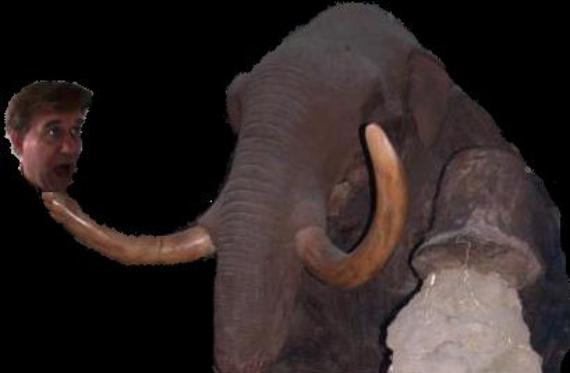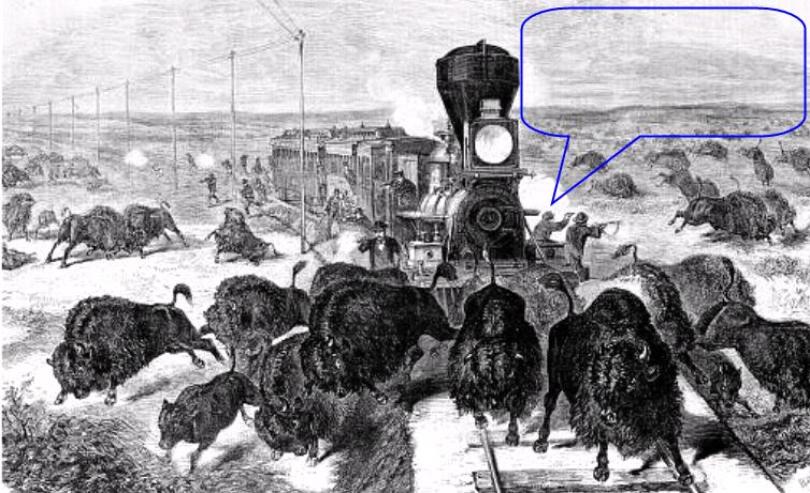| Adapted for the Internet from: Why God Doesn't Exist |
1.0 The three Woolly theories
How are the detectives investigating the murder of the Woolly Mammoth faring? Are they doing any
better than the boys inspecting Neanderthal bones?
Like with Neanderthal, those who study Woolly have not come up with many choices. It's the same old,
same old. Take your pick. You have climate, disease, or Man. [1] That's it! What else could an
anthropologist come up with? The student is not allowed to explore beyond this at the university, and
he certainly won't read a different theory in the journals because the editors hold the same opinions as
those teaching the subject at the universities. Anything outside of these proposals is considered heresy.
The peers will criticize it to such an extent that it will end up not being published.
Graham is convinced it is temperature. MacPhee says that the bugs did them in. Martin champions
overkill. The furry, elephant-like animals ran away from the dreadful weather, from the flu, or from a
monkey who had recently descended from the trees. We need only spend a brief moment on each to
debunk these ridiculous proposals.
2.0 Climate change
It is perplexing to realize that people still believe that climate has something to do with the extinction of
species. Perhaps Graham has attended too many of Al Gore's presentations and believes that Man will
be the next victim of the weather.
Proponents of climate-induced extinctions simply have to address two questions: selectivity and
migration. Why did Neanderthal freeze to death 30,000 B.C. and Woolly 20,000 years later? Why didn't
Neanderthal build a fire or hide inside a cave? Why didn't Woolly go south or evolve into a fatter or
hairier animal?
We're done. (That was quick!)
3.0 Disease
MacPhee dismisses the chilly theory and has put his money on disease. Selectivity also stands in his
way, but I am more concerned about his understanding of crowd vectors, which is the mechanism he
proposes for extinction. He would do well to review the basics before attempting to publish another
theory involving bugs.
When the Spaniards visited the Aztecs or when the white man visited the redskin or some hunter
gatherer in the Pacific, the bugs flowed in the direction of the more primitive societies. Why? Why didn't
the primitives pass crowd diseases to the invaders?
The answer is that they had none. Part of the reason for this is that hunter-gatherers and subsistence
farmers typically have neither pets nor pens. There were no cattle, or sheep, or horses, or pigs, or
chickens on the left side of the Atlantic. The Amerindians had yet to invent corrals, coops, and barns.
Perhaps, the only large animal that the natives ever domesticated was the llama.
Now imagine a hunter-gatherer. He hasn't even domesticated a plant. I am not referring to a sedentary,
part time farmer, part time hunter like the Sioux. We are talking about the Clovis, primitive, 100% hunter-
gatherers who had extremely low population densities. Not only would it have been extremely difficult
for Clovis to catch the flu, but he had no way of propagating it. He simply didn't have the numbers! A
sick hunter-gatherer coughs in the wind!
But assuming that extraterrestrial aliens passed an unspecified disease to Clovis and that some of them
survived and built immunities, this would only reinforce the first law of diseases:
- It is next to impossible that there has ever been a disease that drove a species to extinction.
Mother Nature won't allow it! Even after the devastating 14th-Century Black Death, the number of people
that remained alive exceeded the number of people who died (Fig. 1).
MacPhee should make it a point to visit Mexico or Peru some time in his life. This way he won't have to
take my word for it. He will verify that at least some Aztecs and Incas survived the diseases imported by
the Spaniards.
| Woolly got cold feet |
R. Graham et al., Pleistocene Extinctions: Chronology, Non-analog Communities, and Environmental Change, AMNH (1998). R. MacPhee, Interview with Ross MacPhee, Scientific American (Feb. 4, 2002). P. Martin, Twilight of the Mammoths: Ice Age Extinctions and the Rewilding of America, Berkeley UC Press (2005). |

5.0 Conclusions
What died out 65 million years ago were the ancient dinosaurs. Their time was up! What crossed into
the Cenozoic were the new masters of Earth: the tiny mammals that crawled at the dinos' feet. Likewise,
what died 10,000 years ago in North America was the old guard: Smilodon, Arctodus, Dire Wolf,
Megatherium, Camelops, etc. What survived were the new species, among which we find Man and the
buffalo.
Doesn't this raise a flag?
The relativists of Anthropology casually mention this interesting 'curiosity' in passing, but the lesson
always escapes them. The scholars summarily brush aside the clue with idiotic statements such as that
the new species had better adaptations and then continue talking about climate, disease, and overkill
for the rest of the day.
Why?
Why is it that the species that have been around for a while vanish and not the new ones? Why were the
amphibians replaced by the pelycosaurs and the pelycosaurs by the dinos? Why did the cycadeoids
decline and the flowering plants expand towards the end of the Cretaceous? Why wasn't it ever in
reverse? How can climate, disease, and overkill possibly be a valid explanation for the North American
magafaunal extinction in light of these trends?
4.0 Overkill
The overkill people also have the nagging selectivity issue to resolve. Why did the mastodon disappear
and not the recent immigrant, the American Bison? Doesn't it strike the anthropologists and paleonto-
logists as strange that it is always the animals that have been around for too long that die out? For
example, Woolly had been around for 300,000 years, about the same as Neanderthal. [1] The American
Bison, in contrast, was a relatively new species. It appeared in America about the same time as Clovis.
In fact, if is tentative to conclude that Clovis followed the bison into America and only hunted mastodons
and Woollys on the side. Certainly, Martin won't object if I argue that Clovis had no choice but to change
his diet when the hairy elephants were gone for good! Obviously, Clovis didn't just eat elephant meat.
So why didn't Clovis wipe out the buffalo?
Guthrie uses a similar reasoning to debunk disease and overkill as viable theories for the extinctions of
the Pleistocene megafauna:
- " Species that survived the Pleistocene, for example, bison (Bison priscus,
which evolved into Bison bison), wapiti (Cervus canadensis) and, to a
smaller degree, moose (Alces alces), began to increase in numbers and
continued to do so before and during human colonization and before the
regional extinction of horse (Equus ferus) and mammoth (Mammuthus
primigenius). These patterns allow us to reject, at least in AK–YT, some
hypotheses of late Pleistocene extinction: 'Blitzkrieg' version of simulta-
neous human overkill, 'keystone' removal, and 'palaeo-disease'. " [1]
The weak minded anthropologist answers something lame like:
- " During this same period, other megafauna vanished and were replaced to
some degree by immigrant Eurasian animals that were better adapted to
predatory humans. The American Bison, technically a dwarf form, was one
of these animals." [1]
You have to be quite gullible live at peace with such a reply. People with little imagination merely
repeat what they were told by the 'experts' in college. These are the same people who later serve
on peer review boards and prevent you from publishing a dissenting theory because it destroys
the religion they have grown accustomed to.
Now in what ways were the bison better adapted to predatory humans? Did they have turtle-like
armor protecting their bodies from arrows like Glyptodon, who went extinct about the same time as
the Woollys? Did the bison outrun Clovis spears? Were the buffaloes faster than Miracinonyx studeri,
who became extinct before Clovis discovered America? Didn't the American Indians hunt buffalo en
masse? Weren't the American Indians far more numerous (perhaps a million in the days of Columbus)
than the handful of timid Clovis pilgrims who crossed the Bering on foot? Why didn't the last American
Indians exterminate the buffalo if these animals were practically their entire lifeline?
- " The buffalo meant a lot of different things to most of America's Native
People's. They were food and clothing, tools and utensils... out of the
buffalo came almost everything necessary to daily life... a major part of
Indian life was oriented in and around the buffalo herds. They moved
with them during all but the winter months. The buffalo's habits and
kinds were studied intensely, and in time the Indians put virtually every
part of the beast to some utilitarian use." [2]
Recall that in the 15th Century, buffalo were like the sands of the desert, living side by side with the
Indians:
- " Millions of buffalo once roamed North America, grazing the plains and
prairies and populating the mountains. Historical documents around
the time of Columbus's arrival describe the animals' importance to the
indigenous people. According to early explorers, 'the plains were black
and appeared as if in motion" with buffalo herds.' " [3]
How could this possibly be if the buffalo was the favorite dish of so many humans (Fig. 1)?
Fig. 1 That nagging selectivity problem ! |


| Let's pray that at least some of them survive God's plague, or it's gonna get awfully crowded up here in heaven! |

| I don't understand it, Bill. How is it that a handful of Clovis pilgrims wiped out the Woollys and the mastodons in just a few years, but millions of Indians weren't able to rid us of this plague in decades? |
Fig. 1 The first law of diseases Sometimes diseases leave some people alive. Otherwise, there wouldn't be anyone left to bury the dead! |
- Module main page: Background Extinctions: How did Neanderthal and Woolly wither away?
Pages in this module:
- 1. The differences between a paleontologist and an anthropologist
2. Stringer: The mighty hunter that caught a cold
3. Tattersall and Diamond: The Great Neanderthal-CroMagnon World War (40,000 - 25,000 B.C.)
4. Trinkaus and Wolpoff: How two top predators 'did it.'
5. Klein: Education is not what it used to be
6. This page: Graham, MacPhee, and Martin: Woolly got cold feet
7. So then, how did Neanderthal and Woolly disappear?
- ________________________________________________________________________________________
- Copyright © by Nila Gaede 2008